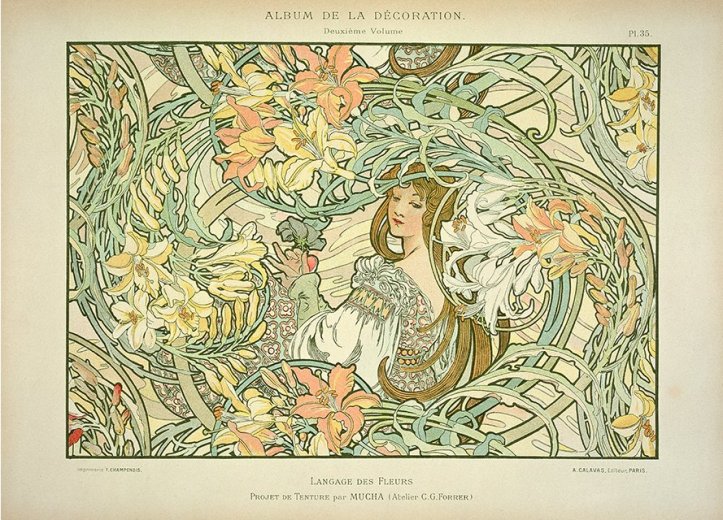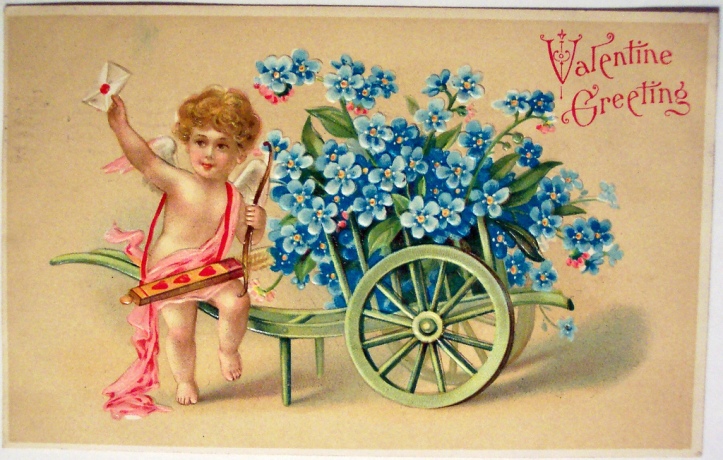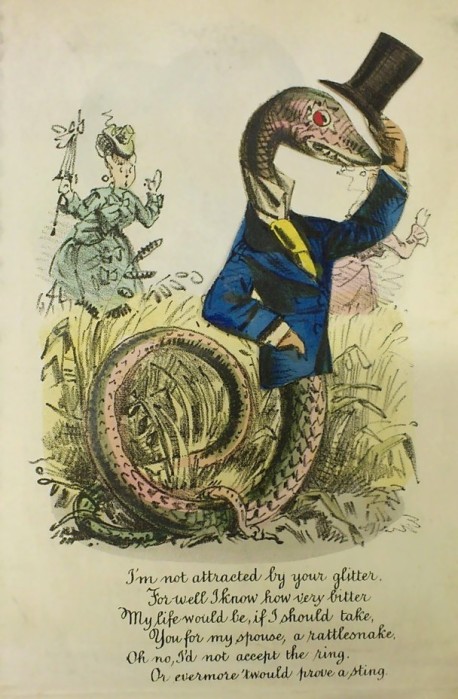
Although floriography existed in the ancient world and throughout the Renaissance, it hit its height of popularity in the nineteenth century. Mary Wartley Montagu is credited with bringing it to England in the early eighteenth century from her travels to the Ottoman Empire, where the court was fascinated with tulips. Tulipomania had come and gone a hundred years before, but European interest in botany was just beginning, contributing in no small part to the success of guides to the language of flowers.
Several such guides were available throughout the nineteenth century, many of them embellished with illustrations or even poetry. Hundreds of editions were sold around the world, and the craze influenced popular culture, with floriography appearing in books by Austen and the Brontes. The Pre-Raphaelite Brotherhood used it extensively in many of their paintings, using the symbolism of the flowers to communicate themes to their audience in a language they would understand.
In a society as relatively repressed as Victorian Britain, floriography must have presented tantalizing possibility. One could say anything without saying anything at all. Rather involved love affairs could take place almost entirely with flowers. Whole conversations could be had in a single bouquet. It had the added benefit that it would have been a hobby for the genteel; it required a certain degree of literacy, knowledge of botany, and means with which to obtain the plants necessary to communicate one’s message. While one might pass daisies (“I share your sentiment”) every day, African Marigolds (“vulgar minds”) or Helmet Flowers (“knight-errantry”) might present a greater challenge.
Interestingly enough, for every plant with a positive meaning, there is at least one more with a severely negative one. Reading Kate Greenaway’s The Language of Flowers (1884), it is reassuring that those courted by people they didn’t fancy could put them off without being outwardly rude, from Red Balsam (“touch me not”) to the rather frightening Wild Tansy (“I declare war against you”).
Whether you’re researching a book, decoding a painting, or just looking for a Valentine’s idea for your loved one (or worst enemy), floriography is good fun. Here are some lists of my favorites. Scroll to the bottom for links to some nineteenth century guides you can read in full online or download for your e-reader. Have fun!
A Beginner’s Guide to the Language of Flowers
“When nature laughs out in all the triumph of Spring, it may be said, without a metaphor, that, in her thousand varieties of flowers, we see the sweetest of her smiles; that, through them, we comprehend the exultation of her joys; and that, by them, she wafts her songs of thanksgiving to the heaven above her, which repays her tribute of gratitude with looks of love. Yes, flowers have their language. Theirs is an oratory that speaks in perfumed silence, and there is tenderness, and passion, and even light-heartedness of mirth, in the variegated beauty of their vocabularly.” – Frederic Schoberl, 1834.

Positive
| Almond (flowering) | Hope |
| Ambrosia | Love returned |
| Arbor Vitae* | Unchanging Friendship. Live for me. |
| Cloves | Dignity |
| Clover, four-leaved | Be mine |
| Coreopsis Arkansa | Love at first sight |
| Coriander | Hidden worth |
| Corn | Riches |
| Daffodil | Regard |
| Daisy, Garden | I share your sentiments |
| Forget Me Not | Forget Me Not |
| Ivy | Fidelity. Marriage. |
| Lemon blossoms | Fidelity |
| Mallow, Syrian | Consumed by love |
| Oak Tree | Hospitality |
| Oak Leaves | Bravery |
| Pine-apple | You are perfect |
| Potato | Benevolence |
| Ranunculus | You are radiant with charms |
| Snowdrop | Hope |
| Strawberry Tree | Esteem and Love |
| Tulip, Red | Declaration of love |
| Tulip, Variegated | Beautiful eyes |
| Tulip, Yellow | Hopeless love |
| Venice Sumach | Intellectual excellence |
| Walnut | Intellect. Strategem. |
| Water Lily | Purity of heart |

Negative
| Achillea Millefolia | War |
| Aconite (Wolfsbane) | Misanthropy |
| Adonis, Flos | Painful recollections |
| Agnus Castus | Coldness. Indifference. |
| Almond (common) | Stupidity. Indiscretion. |
| Amaranth (cockscomb) | Foppery |
| Apple, Thorn | Deceitful charms |
| Asphodel | My regrets follow you to the grave. |
| Bachelor’s Buttons | Celibacy |
| Balsam, Red | Touch me not |
| Barberry | Sourness of temper |
| Basil | Hatred |
| Bay leaf | I change but in death. |
| Bay (Rose) Rhododendron | Danger. Beware. |
| Belladonna | Silence |
| Belvedere | I declare against you |
| Bilberry | Treachery |
| Birdsfoot Trefoil | Revenge |
| Blue-flowered Green Valerian | Rupture |
| Burdock | Touch me not. |
| Butterfly Weed | Let me go. |
| Carnation, Striped | Refusal |
| Carnation, Yellow | Disdain |
| Chequered Fritillary | Persecution |
| China or Indian Pink | Aversion |
| Citron | Ill-natured beauty |
| Clotbur | Rudeness. Pertinacity. |
| Coltsfood | Justice shall be done |
| Columbine | Folly |
| Convulvulus, Major | Extinguished hopes |
| Creeping Cereus | Horror |
| Crowfoot | Ingratitude |
| Cypress | Death. Mourning. |
| Dragonwort | Horror |
| Enchanter’s Nightshade | Witchcraft. Sorcery. |
| Flytrap | Deceit |
| Fool’s Parsley | Silliness |
| Frog Ophrys | Disgust |
| Fuller’s Teasel | Misanthropy |
| Fumitory | Spleen |
| Garden Anemone | Forsaken |
| Hand Flower Tree | Warning |
| Hellebore | Scandal |
| Hemlock | You will be my death |
| Hydrangea | Heartlessness |
| Japan Rose | Beauty is your only attraction |
| Leaves (dead) | Melancholy |
| Lavender | Distrust |
| Lily, Yellow | Falsehood |
| Licorice, Wild | I declare against you |
| Lobelia | Malevolence |
| Mandrake | Horror |
| Milfoil | War |
| Mosses | Ennui |
| Mourning Bride | Unfortunate attachment |
| Moving Plant | Agitation |
| Mushroom | Suspicion |
| Nettle, Burning | Slander |
| Pennyroyal | Flee away |
| Raspberry | Remorse |
| Rose, York and Lancaster | War |
| Rue | Disdain |
| Saint John’s Wort | Animosity |
| Spiked Willow Herb | Pretension |
| Tamarisk | Crime |
| Tansy (Wild) | I declare war against you |
| Thistle, Scotch | Retaliation |
| Trefoil | Revenge |
| White Rose (dried) | Death preferable to loss of innocence |
| Whortleberry | Treason |
| Wormwood | Absence |

Sexy
| African Marigold | Vulgar minds |
| Darnel (ray grass) | Vice |
| Dittany of Crete, White | Passion |
| Dragon Plant | Snare |
| Everlasting Pea | Lasting Pleasure |
| Fleur-de-Lis | Flame. I burn. |
| Geranium, Lemon | Unexpected meeting |
| Geranium, Nutmeg | Expected meeting |
| Grass | Submission |
| Jasmine, Spanish | Sensuality |
| Linden or Lime Trees | Conjugal Love |
| Orange Flowers | Bridal festivities |
| Peach Blossom | I am your captive |
| Quince | Temptation |
| Rose, Carolina | Love is dangerous |
| Rose, Dog | Pleasure and pain |
| Tuberose | Dangerous pleasures |
| Vine | Intoxication |

Weird
| Aloe | Grief. Religious superstition |
| Cereus (Creeping) | Modest genius |
| Christmas Rose | Relieve my anxiety. |
| Cistus, Gum | I shall die to-morrow |
| Colchicum, of Meadow Saffron | My best days are past. |
| Dandelion | Rustic Oracle |
| Helmet Flower (Monkshood) | Knight-errantry |
| Houseleek | Domestic industry |
| Indian Cress | Warlike trophy |
| Lady’s Slipper | Win me and wear me |
| Lint | I feel my obligations |
| Oats | The witching soul of music |
| Passion Flower | Religious superstition |
| Persimon | Bury me amid Nature’s beauties |
| Poppy, White. | Sleep. My bane. My antidote. |
| Prickly Pear | Satire |
| Violet, Yellow | Rural happiness |
Jessica Cale
Further Reading
Greenaway, Kate. The Language of Flowers (1884)
Schoberl, Frederic. The Language of Flowers; With Illustrative Poetry (1834)
Tyas, Robert. The Sentiment of Flowers; or, Language of Flora (1836)
*Arbor Vitae was also slang for penis at this time.

Fascinating!
LikeLiked by 1 person
Thanks for stopping by, Leigh! Glad you enjoyed! 🙂
LikeLike
While I knew there was a language of flowers, I had no idea that it was quite so extensive. How did people remember all this, and remember all the subtleties?
Thanks for this!
LikeLiked by 1 person
You’re so welcome! The Greenaway book is a hundred pages long, if you can believe it. The first fifty are alphabetical my plant, and the second fifty are arranged by meaning. I wouldn’t be able to remember them all. I think you’d have to have one of the guides at home to decode any bouquets received. Inconvenient — unless you’re the publisher. 😉
LikeLiked by 1 person
Hi I have the little pirate boy with a gun valentines card can you give me any more info this link is the only one on the web I can find of it any help is appreciated thanks
LikeLike
I’m sorry, I don’t have more information on that particular valentine. It’s a great find, though!
LikeLike